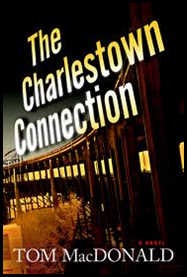“He never sold drugs, never touched little kids. he made his money on stand-up crime: forgery, sports fixing, cons, street hustles, the occasional heist.”
Equal parts whodunit, murder mystery and caper novel, with a dash of conspiracy thriller elements, a la The Da Vinci Code. But that’s where any equality ends. The Charlestown Connection goes beyond all of those to reach new heights in crime fiction. And this is a debut novel? Tom MacDonald, where have you been hiding?
Imagine debuting in the major leagues by pitching to Ted Williams, Carl Yastrzemski and Jimmie Foxx, sticking with the Boston theme. Now, imagine you struck out the side on nine pitches. That’s what Tom MacDonald has done by choosing to walk the hallowed grounds of Boston’s Charlestown neighborhood, the turf of such super stars as Robert B. Parker, Dennis Lehane and Chuck Hogan, you fellas can move over and make room at the top, because Tom MacDonald deserves a seat. I’m not sure I have ever read a better debut novel. Mr. MacDonald set the bar high, then cleared it in Superman fashion.
This book just jumped the turn stiles to move to the front of the line for best crime fiction of the year. Both hardboiled and noir, without using the usual clichés. It achieves a hardboiled “feel” through setting, an edginess, a sense of realness and the development of the characters. It gets it’s “noir-ness” not through the usual morally bankrupt cast of characters (indeed, even the bad guys have a certain shady attractiveness) nor through the commission of evermore despicable and lewd crimes until the protagonist is so irredeemable that the devil considers retirement. No, it gets that feeling of noir through a certain sense of stoicism by the main players, a sense of darkness in the setting inside one of America’s largest public housing neighborhoods and in Charlestown’s colorful, troubled, and criminal past as well as the mix of cultures.
Where most hardboiled fiction is dialog driven , “Charlestown” has full grown characters and is more developed through the internal dialog, and observations of the protagonist, than on snappy one liners and tougher than tough tough guys. Although some of the life situations of the main characters will be familiar i.e. a recovering alcoholic hero, a paraplegic side kick, they are either not over done or are used in such an original and fresh way as to avoid any thoughts of cliché. And where noir tends to have a reliance on dark, brooding themes, a certain decay in the souls of the characters and a reliance on sex and sexual themes, or at the very least degenerate crimes and sins to drive the plot, this novel achieves that familiar sense of darkness without resorting to sensationalism, melodrama or gothic language.
From the opening paragraph, one of the best I have read in awhile, MacDonald establishes his debt to the greats of both those genre, while resolutely pointing the way towards the future and where, with a bit of artistry and a masters creativity, the genres can go:
“I drove my corroded Plymouth Acclaim down Bunker Hill Street and parked at a curb in Hayes Square. The car is too old to be worth any money, but not old enough for antique antique plates – a double indignity. The summer sun faded to dusk, giving the Tobin Bridge its twilight complexion. Like a tipsy lady in a dimly lit bar, the Tobin looks better at night than in the morning. A wino came out of the package store carrying a flat brown bag. He unscrewed the bottle cap, swigged and walked into the projects.”
Dermot Sparhawk is a half Micmac Indian, half Irish son of Charlestown. A one time All-American linebacker at Boston College and headed towards being a first round draft choice for the pros when a knee injury lead to a botched surgery ending all dreams of that future. He now works for a food bank at Saint Jude Thaddeus church in Charlestown. He has tried to kill his disappointment with cheap whiskey until suffering a “rum fit” and being strapped in bed in a detox unit. He is twenty-nine days sober when his godfather, Jeepster Hennessy collapses at his feet inside the food bank, a knife in his back. Jeepster only has time to mutter a few cryptic words and to hand Dermot a ring of three keys before expiring.
Soon, a police detective, the FBI, some Irish mobsters, and IRA connected criminals, are asking puzzling questions and making threats. Dermot is prompted to investigate the murder. Soon, he comes to learn that all of the above had reason to suspect that Jeepster wasn’t the victim of a random crime in dirty neighborhood, a drug deal gone bad, and more than one on the list might have wanted to do Jeepster harm.
Dermot’s enquiries along with questions asked by the police, FBI, and the shady elements soon lead him to think that Jeepster may have double crossed somebody in a criminal enterprise, and though a drug deal gone bad would seem to be the most likely factor, a high stakes poker game, counterfeit money, a failed delivery of information or stolen property all seem like possible motives. Dermot, armed with so few clues, enlists an ex team mate, and his Indian cousin to help with his search. By tracking down on the internet some of the words mentioned by Jeepster – after getting realistically sidetracked by way too many search engine hits, the trio uncover a hidden chat room and apparent coconspirators that throw counterfeit art works into the mix. mean while, the FBI’s Homeland Security branch is pursuing a Somali/ al Qaeda terrorist angle and even moves a female agent into Jeepster old apartment.
Dermot, using infinite patients, street smarts, intuition and his family and neighborhood connections pursues each clue doggedly, and encounters enough dead ends and red herrings to confound the most seasoned investigator. MacDonald uses a beautiful touch to hide which is which. Even the most experienced and adept at figuring out the puzzle, will be surprised, yet all the clues are there.
Employing all of the best elements from multiple branches of the crime fiction/thriller family tree against a historical backdrop of Charlestown and one of the most daring true crimes ever perpetrated, in addition to craftsmanship not usually found in a first time author, MacDonald has carved out a spot for himself at the very top. He is not an up and coming author, he arrived in style. Get used to seeing his name, because this author is going to be around for a long, long time.
Tom MacDonald was born in Dorchester, and raised in Braintree, so his easy  knowledge of Boston come naturally. After a career in business, he now runs St. Mary–St. Catherine of Siena Parish as Director of Social Ministries. MacDonald graduated from Stonehill College with a degree in sociology8 worked as a computer programmer before earning an MBA at Boston College. He then chose to pursue a writing career by attending University of Southern Maine’s Stonecoast MFA program, where he added that degree as well.
knowledge of Boston come naturally. After a career in business, he now runs St. Mary–St. Catherine of Siena Parish as Director of Social Ministries. MacDonald graduated from Stonehill College with a degree in sociology8 worked as a computer programmer before earning an MBA at Boston College. He then chose to pursue a writing career by attending University of Southern Maine’s Stonecoast MFA program, where he added that degree as well.
I want to thank the publishers, Oceanview Publishing for striking gold in bringing Tom on board for what I am sure will be a mutually satisfying association, and with providing me with not only a reviewers copy, but a signed first edition. It’s future value will probably send future generations of mine to the finest schools.
The Dirty Lowdown
Article first published as Book Review: The Charlestown Connection by Tom MacDonald on Blogcritics
Copyright © 2011 Robert Carraher All Rights Reserved
http://the-dirty-lowdown.blogspot.com/


No comments:
Post a Comment